

If you are clinically concerned that your patient has an acute neurosurgical shunt blockage, please refer urgently to your local Emergency Department unless your patient lives within the , in which case please refer directly to our on-call via Refer-a-Patient. We can review whether the patient can be seen directly in our SDEC or whether they should be seen in ED. (FOR FURTHER CONSIDERATION OF WORDING - Perhaps 'local hospital' or 'for GP's from xxx? What happens if they attend ED in another hospital? )
If your patient has Normal Pressure Hydrocephalus, shunt blockage does not present with typical symptoms (vomiting, headaches and confusion), and can be managed via the helpline below.
There is a hydrocephalus advice line in working hours that is covered by our advanced nurse practitioners:
0117 414 6613
If the patient has evidence of new hydrocephalus without a shunt in situ, please refer to the on-call via Refer-a-Patient, unless the report specifies that the patient has normal pressure hydrocephalus – in which case see the Normal Pressure Hydrocephalus section.
Efforts are made to ensure the accuracy and agreement of these guidelines, including any content uploaded, referred to or linked to from the system. However, BNSSG ICB cannot guarantee this. This guidance does not override the individual responsibility of healthcare professionals to make decisions appropriate to the circumstances of the individual patient, in consultation with the patient and/or guardian or carer, in accordance with the mental capacity act, and informed by the summary of product characteristics of any drugs they are considering. Practitioners are required to perform their duties in accordance with the law and their regulators and nothing in this guidance should be interpreted in a way that would be inconsistent with compliance with those duties.
Information provided through Remedy is continually updated so please be aware any printed copies may quickly become out of date.